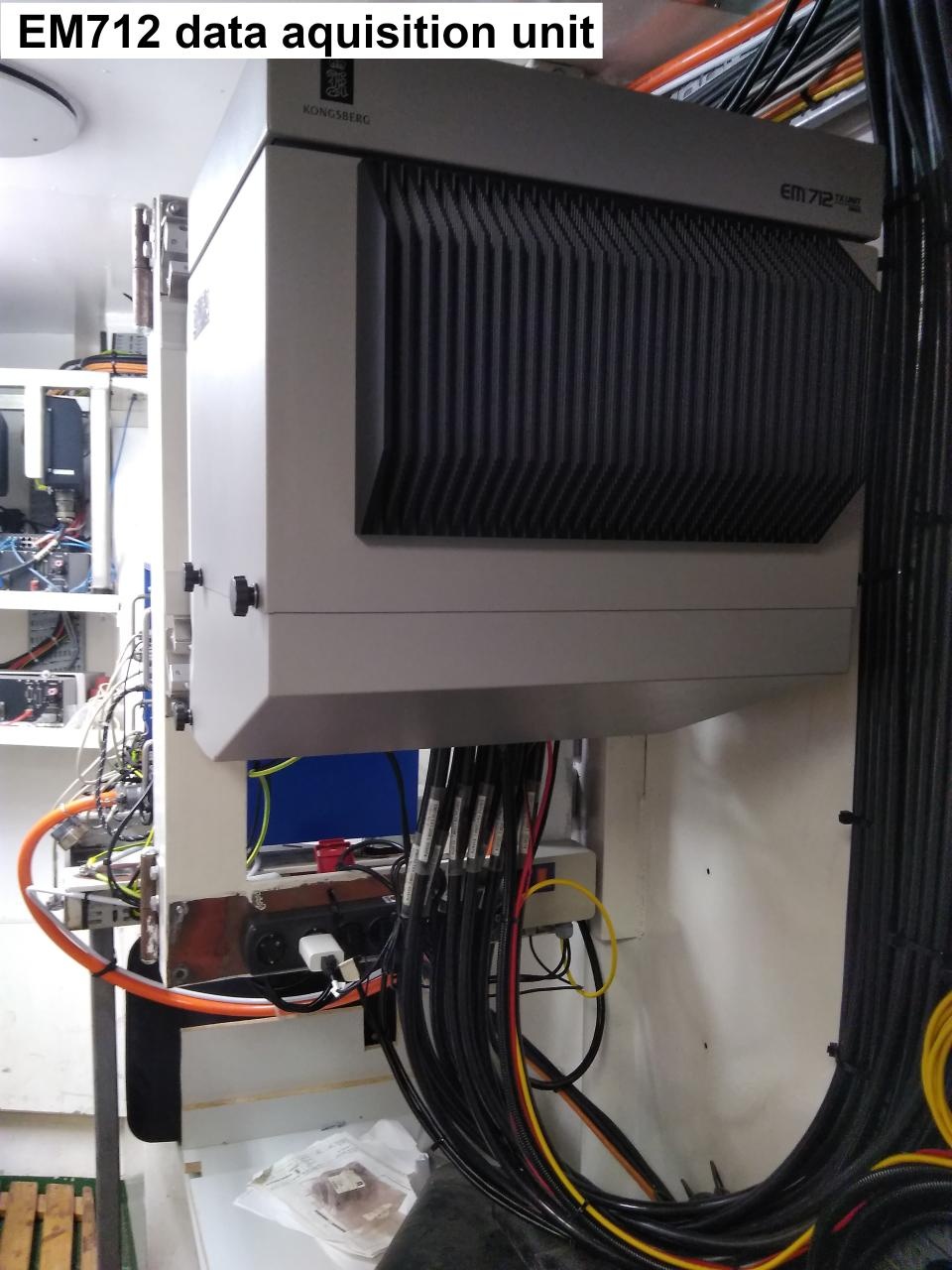Please note that operations of the Multibeam Echo Sounder EM712 requires experienced scientific staff on board and can be only operated upon request. The system is not operated by the ship's crew. Request operations with the Multibeam Echo Sounder EM712 to AWI-Logistics in sufficient time prior to the cruise and clarify the data transfer after the cruise. |
Summary
Multibeam EM712 is a high-resolution seafloor mapping system. It is suitable for water depths up to 2000m depending on the configuration of the transducers. Maximum ping rate is 30Hz and maximum fan width 140° and depth resolution 1cm. Data from the water column may also be stored. |
| Manufacturer |
Kongsberg |
| Model |
EM712 |
| Serial No. |
210 |
| Type |
echo sounder |
| SENSOR-Link |
↪ |
|
Transducer Frequency
Contacts
|
Name
|
Institution
|
Role
|
| FIELAX GmbH |
FIELAX Gesellschaft für wissenschaftliche Datenverarbeitung mbH |
Engineer In Charge |
|
Components
The EM712 consists of a transducer array for transmitting (Tx) and an array for receiving (Rx), the transceiver unit, the data aquisition PC with the aquisition software SIS and two processing PCs (bridge and Messraum) with the software Caris HIPS/SIPS.
The software "Seafloor Information System" (SIS) contains several graphic displays for quality checks and for system calibration as well as other tools. SIS supports an online/realtime data cleansing. Both SIS and the processing software Caris HIPS/SIPS are protected via a dongle. Please contact the bridge staff for suppport.
Sound velocity can alternatively been received from two sensors: from Sound Velocity Probe (Valeport Mini SVS) or calculated velocities from sensor Thermosalinograph.
Ships position is received from GPS Receiver Trimble Marine SPS461 . Ships orientation is received from Motion Sensor (PHINS).
Subdevices
|
Name
|
Model
|
Serial Number
|
SENSOR-
Link
|
| Multibeam EM712 Rx |
|
n/a |
↪ |
| Multibeam EM712 Tx |
|
n/a |
↪ |
|
Position
| Info |
The system consists of several units. Transducer arrays are installed in the keel of RV Heincke. Electronics are found in the Lotgeraeteraum. Work places are situated on the bridge and in the Messraum. |
|
Data logging, storage and archiving
Logged parameters
|
Parameter
|
Sensor Output Type
|
Unit
|
| depth |
depth |
m |
|
Central geographical ship's position and time standard
The GPS position of the Trimble GPS receiver antenna is stored in the data files. The position is NOT centralized to the SES2000 transducers. Heave correction between the motion sensor and the transducer are calculated in the motion sensor and corrected values are transferred to the SES2000. Time synchronisation is achieved via NTP. Centralization of the GPS position to the transducer is achieved by SIS software. GPS antenna position and transducer position related to the motion sensor position as a reference point are stored in the data files. Pay attention that in case of failure of the Trimble GPS sensor the Saab GPS sensor may be used as the reference GPS source. Please contact the bridge staff for information about the GPS receiver in use. Heave correction values are only available for the Trimble GPS receiver. Heave correction between the motion sensor and the transducer is calculated
in the EM712 transceiver unit. UTC time synchronisation of the transceiver unit is achieved via GPS with PPS. The PC is synchronised with UTC via the Windows-Domain-Affiliation to ensure a correct naming of the data files. |
Rawdata storage on board
The data acquisition software SIS creates raw data on the local drive of the computer. The EM712 data are not transferred to DSHIP. |
|| root directory | E:\sisdata\raw\ or \\xdc\home\data\mbes\ ||
|| directory name | CruiseNo e.g. HE590 ||
|| file name | nnnn_YYYYMMDD_hhmmss_Suffix.all ||
|| Data volume (MB per day) ca | 2800 ||
|| Number of files per day ca | 50 || |
Dship
Only the water depths of the central beam are written to DShip via serial connection |
|| Device name | Multibeam Echosounder ||
|| Parameters | Depth \[m\] || |
Data archiving on land
After consultation with the data scientist and AWI Logistics the EM712 data including meta data may be transferred to PANGAEA (https://www.pangaea.de/). |
Documentation




